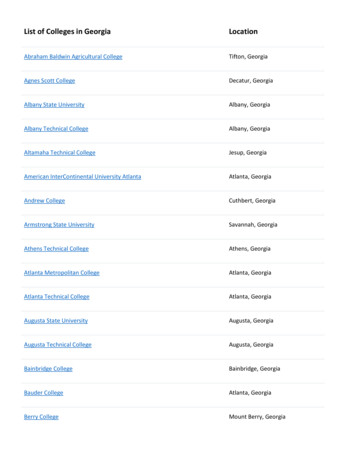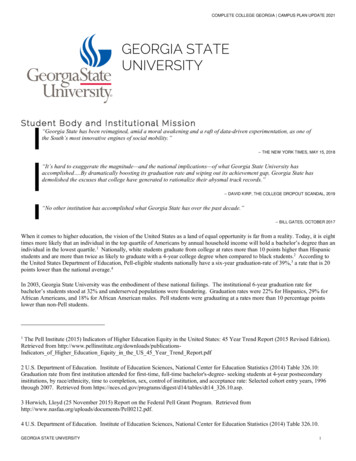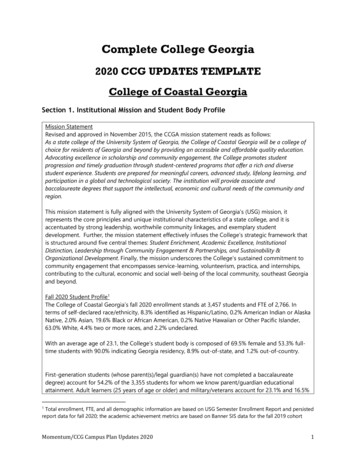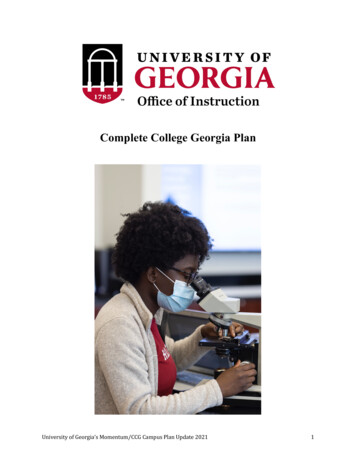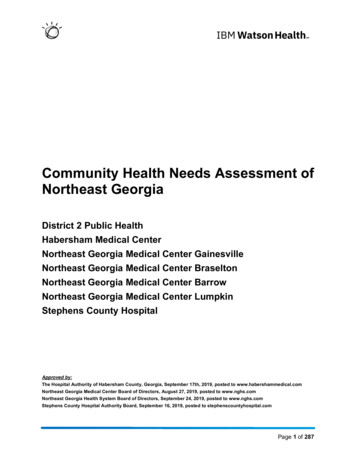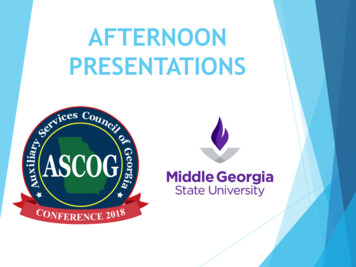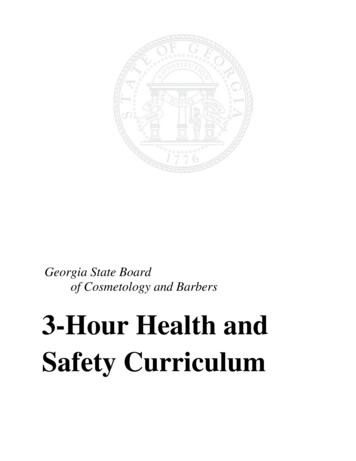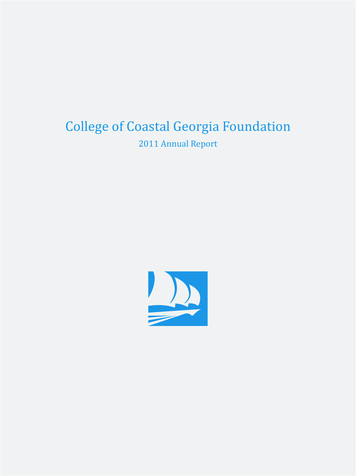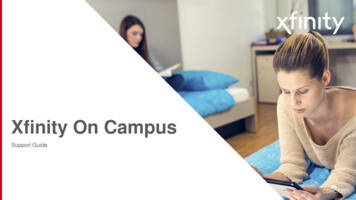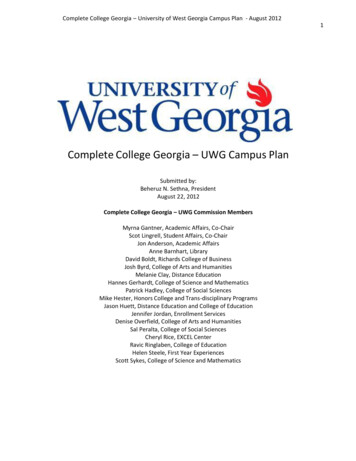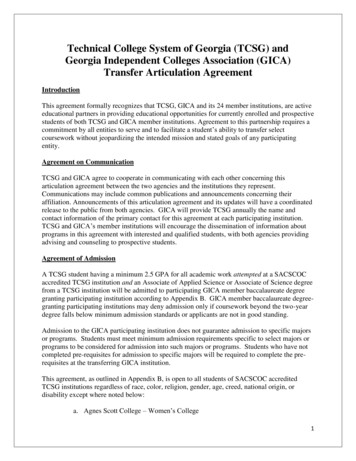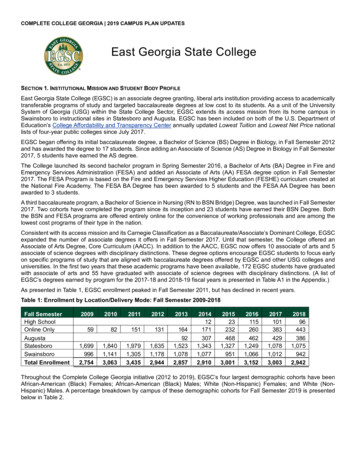
Transcription
COMPLETE COLLEGE GEORGIA 2019 CAMPUS PLAN UPDATESEast Georgia State CollegeSECTION 1. INSTITUTIONAL MISSION AND STUDENT BODY PROFILEEast Georgia State College (EGSC) is an associate degree granting, liberal arts institution providing access to academicallytransferable programs of study and targeted baccalaureate degrees at low cost to its students. As a unit of the UniversitySystem of Georgia (USG) within the State College Sector, EGSC extends its access mission from its home campus inSwainsboro to instructional sites in Statesboro and Augusta. EGSC has been included on both of the U.S. Department ofEducation’s College Affordability and Transparency Center annually updated Lowest Tuition and Lowest Net Price nationallists of four-year public colleges since July 2017.EGSC began offering its initial baccalaureate degree, a Bachelor of Science (BS) Degree in Biology, in Fall Semester 2012and has awarded the degree to 17 students. Since adding an Associate of Science (AS) Degree in Biology in Fall Semester2017, 5 students have earned the AS degree.The College launched its second bachelor program in Spring Semester 2016, a Bachelor of Arts (BA) Degree in Fire andEmergency Services Administration (FESA) and added an Associate of Arts (AA) FESA degree option in Fall Semester2017. The FESA Program is based on the Fire and Emergency Services Higher Education (FESHE) curriculum created atthe National Fire Academy. The FESA BA Degree has been awarded to 5 students and the FESA AA Degree has beenawarded to 3 students.A third baccalaureate program, a Bachelor of Science in Nursing (RN to BSN Bridge) Degree, was launched in Fall Semester2017. Two cohorts have completed the program since its inception and 23 students have earned their BSN Degree. Boththe BSN and FESA programs are offered entirely online for the convenience of working professionals and are among thelowest cost programs of their type in the nation.Consistent with its access mission and its Carnegie Classification as a Baccalaureate/Associate’s Dominant College, EGSCexpanded the number of associate degrees it offers in Fall Semester 2017. Until that semester, the College offered anAssociate of Arts Degree, Core Curriculum (AACC). In addition to the AACC, EGSC now offers 10 associate of arts and 5associate of science degrees with disciplinary distinctions. These degree options encourage EGSC students to focus earlyon specific programs of study that are aligned with baccalaureate degrees offered by EGSC and other USG colleges anduniversities. In the first two years that these academic programs have been available, 172 EGSC students have graduatedwith associate of arts and 55 have graduated with associate of science degrees with disciplinary distinctions. (A list ofEGSC’s degrees earned by program for the 2017-18 and 2018-19 fiscal years is presented in Table A1 in the Appendix.)As presented in Table 1, EGSC enrollment peaked in Fall Semester 2011, but has declined in recent years.Table 1: Enrollment by Location/Delivery Mode: Fall Semester 2009-2018Fall SemesterHigh SchoolOnline OnlyAugustaStatesboroSwainsboroTotal 2Throughout the Complete College Georgia initiative (2012 to 2019), EGSC’s four largest demographic cohorts have beenAfrican-American (Black) Females; African-American (Black) Males; White (Non-Hispanic) Females; and White (NonHispanic) Males. A percentage breakdown by campus of these demographic cohorts for Fall Semester 2019 is presentedbelow in Table 2.
Complete College GeorgiaEast Georgia State College2019 Campus Plan UpdateTable 2: Fall 2019 Enrollment by Gender and Ethnicity for Each Location and Delivery ModeFall 2019 EnrollmentFemaleBlack or African AmericanWhite (Non-Hispanic Origin)OtherMaleBlack or African AmericanWhite (Non-Hispanic Origin)OtherAugusta Statesboro %17.4%17.8%4.7%As indicated in Table 2, 46 percent of EGSC’s Fall Semester 2019 enrollment are Black students. This is consistent with theprevious five fall semesters when EGSC’s enrollment Black student ranged from 45 to 49 percent of total enrollment. Incontrast, the percentage of enrollment consisting of Black students for the USG State College Sector ranged from 29 to 32percent for the same fall semesters. The characteristics of EGSC’s student body differ from that of the USG State CollegeSector in several other important ways. Over the fall semesters from 2014 through 2018, EGSC averaged fewer Asian (1percent), Hispanic (5 percent) and white (43 percent) percentages of its student body compared to the sector’s Asian (4percent), Hispanic (13 percent) and white (49 percent) students as average percentages of the sector’s student body.For the same fall semesters, EGSC had a lower proportion of adult students at 7 percent compared to 13 percent for thesector. In contrast, the average percentage of EGSC full-time undergraduates was almost 80 percent compared to 66percent for the sector over the same period. Even so, the average percentage of EGSC undergraduates who completed 30or more credit hours in an academic year was 13 percent compared to 16 percent for the sector.Similar differences between EGSC and the USG State College Sector extend to the first-time freshmen (FTF) fall semestercohorts in the proportions of African American, Asian, Hispanic and white students. However, the average percentage ofFTF earning 30 or more credit hours in their initial academic year is 15 percent for both EGSC and the sector.In the area of learning support (LS), EGSC percentages of both black and white FTF students who take both math andEnglish courses in first academic year are higher than comparable average percentages for SC sector black (67 percent)and white (71 percent) for the Fall 2013 through Fall 2017 cohorts. However, EGSC (30.9 percent) lags SC sector (38.9percent) in average percentage of LS English and math FTF who passed both math and English with a C or better duringthe same period.SECTION 2. MOMENTUM YEAR UPDATEEGSC has continued to diligently work on Momentum Year Projects and taken mindful actions to improve student successrates. Among the actions taken are:1. EGSC continues to hone the New Student Orientation (NSO) programs. The Mindset workshops include a session onGrowth Mindset and electronically link students into the CATS 1101 online course component. The Focus 2 CareerDiscernment instruments are still being used to identify appropriate student majors based on aptitude and abilities.During NSO, a student life session is presented to foster a sense of student connection and belonging to the college.The college also provides interactive sessions (majors fair) with faculty wherein students receive initial counseling oncareers and majors. They also receive their two-year academic plan during the majors fair. Mindset is formally taught inthe First Year Experience (FYE) through EGSC’s Critical and Academic Thinking for Success course.2. Students are being pre-registered for Area A courses and are being advised to enroll in a minimum of 15 credit hoursper semester. Approximately 89 percent of our new students are enrolled in Area A. Previously, only 34 percent of ourstudents completed Area A courses within the 30-credit time frame mandated by USG policy. The appropriate choice ofmath courses was determined by the student’s chosen major. Prior to Fall 2018, EGSC had no alternative math pathwayfor non-stem majors. Students were also registered for 9 credits of focus courses. Pre-registration created learningcommunities in blocks of Area A courses.3.2EGSC has implemented the eight-week format for Area A courses during the fall term 2019. Twenty percent of ourofferings in Area A are presented on an eight-week schedule. We anticipate creating eight-week cohort classes (core
Complete College GeorgiaEast Georgia State College2019 Campus Plan Updateclasses) where students can take five courses in a semester using a 3-2 model.4.EGSC utilizes two- and four-year degree plans for all programs of study. These plans have been programmed intoDegreeWorks, and students are advised to register for courses aligned with their degree plan.5. EGSC, for the second year, provided training for faculty related to faculty mindset during its fall workshop, and plans toincorporate mindset training via the Faculty Academy to support this work across the curriculum. Since student mindsetis often impacted by faculty mindset, an expected outcome is more effective communication during classroom instructionand office consultations.6. EGSC has implemented a new Early Alert Policy, requiring faculty to alert the Retention Team when any student missestwo or more classes or when students receive early warning grades by week five of the semester. The retention teamincludes counselors, the director of student conduct, the director of housing, a social worker on the faculty, and otherfaculty.Work planned in the Spring Term and BeyondThe Director of the Center for Teaching and Learning has begun working closely with the Chancellor’s Learning Scholars inthe effort to train faculty on Mindset. This collaboration began with the Fall 2019 Faculty Workshop where the FacultyLearning Scholars held a half-day workshop to train faculty on how to cultivate a Growth Mindset during instruction. At somestage in this academic year, additional training on faculty mindset will be offered during the new professional developmentseries, Faculty Academies.EGSC is implementing in-house advising in the Swainsboro student housing facilities. The plan is to place a full-timeacademic coach in an office situated within a dormitory. The role of the advisor will include, but not be limited to, schedulingregular meetings with students to monitor class attendance and grades in classes, reviewing academic best practices (forexample, time management and study strategies), providing academic consultations, and exploring career pathways.The college will continue to participate in the Gateways to Completion (G2C) system initiative. The college has added threecourses: Quantitative Skills-Reasoning (MATH 1001 & MATH 0097 – counts as one course, including support), EnglishComposition I (ENGL 1101), and English Composition II (ENGL 1102). Work will begin to redesign these courses usingstandardized course design (MATH only) and incorporating high-impact practices into the design components.The faculty have begun using Academic Action Plans as they consult with students who are at-risk of failure. These planshelp to scaffold students’ persistence and self-management by providing insight into their academic goals, class attendance,and the number of missed exams and assignments. Additionally, students are provided with specific and unique actions thatwill enhance their academic achievement.Challenges1. EGSC does not have a career services office for students. Human Resources provides limited access to resources,but there is no active, sequenced, or intentional engagement with students.2. EGSC needs to develop funding sources for professional development. Presently, we have very few resources.3. EGSC needs to continue to focus on retention initiatives.SECTION 3: OTHER INSTITUTIONAL HIGH-IMPACT STRATEGIES, ACTIVITIES & OUTCOMESDuring the 2018-19 academic year, EGSC continued focused on the following four strategies to promote college completion:1.2.3.4.Increase Degree Awards to Most Challenged StudentsOn-time Degree CompletionIncrease Dual Enrollment OpportunitiesEnhance Co-requisite approachesHigh-Impact Strategy 1: Increase Degree Awards to Most Challenged Students Increase in the number of undergraduate degrees awarded to low income students (Pell eligible students)Increase in the number of undergraduate degrees awarded to first generation college studentsRelated CCG GoalGoal 1: Increase in the number of undergraduate degrees awarded by USG institutions.3
Complete College GeorgiaEast Georgia State College2019 Campus Plan UpdateGeneral Description of ActivityAs an open access institution, EGSC strives to serve all students that choose to pursue their education at the college.EGSC is disproportionately chosen by the most challenged students that need financial aid and/or have weak previousacademic preparation. As a result, the college prioritizes supporting these students as they work toward degree completionvia student assistance provided in the EGSC Academic Center of Excellence (ACE), support courses, mini-sessionofferings, advising, and many other methods.Summary of Activities 2018-2019Table 3 below is excerpted from Table A5 in the Appendix and shows the usage of the Academic Centers for Excellence(ACE) for AY 2018 and AY 2019 based on data drawn from GradesFirst. Course Success Rates are determined by studentsearning Cs or better in courses where they sought assistance from the ACE. In addition, Table A5 in the Appendix documentsthe increasing rates of course completion based on the percentages of credit hours earned to attempted since FY 2011-12.*Note: The Swainsboro ACE Staff had a significant issue with EGSC students not checking into the GradesFirst kiosk. Thiscreates insufficient data regarding utilization of the Swainsboro ACE.Table 3: ACE Use Rates for AY 2018 and AY tesFall 20173,295223,36677.0%Spring sta:Overall:Fall 20181,053*35,10568.7%Spring 20191,545*79,664*69.0%66636,00064.4%Spring 20181,98254,88874.0%Fall 20182,789119,84370.7%Spring 20193,639141,64176.6%Fall 20171252,11065.3%Spring 20183216,54183.8%Fall 201895339,81773.9%Spring 20192,13390,30967.0%Fall 20174,086261,47668.8%Spring 20183,46992,46076.6%Fall 20184,795194,76271.1%Spring 20197,317311,61470.8%Fall 2017Results and Lessons LearnedPresented in Table 4 are the number of EGSC’s Fall Semester 2019 FTF broken down by whether they are first generationcollege students. Although the number of EGSC’s Fall Semester 2019 FTF is preliminary and subject to change, the overallpercentage of 29 percent being first generation matches the percentage for EGSC’s Fall Semester 2018 FTF cohort. Alsonote that 40 percent of EGSC Fall 2019 FTF students took courses exclusively online. In addition, while the percentage ofEGSC FTF being first generation was similar to that of the USG State College Sector at about 23 percent in Fall Semester2015, the percentage of USG State College Sector FTF who are first generation has since declined to 18 percent by Fallsemester 2018. As can be seen, EGSC now has 11 percent more first-generation students than the average for the USGState College Sector.4
Complete College GeorgiaEast Georgia State College2019 Campus Plan UpdateTable 4: Fall 2019 First-Time Freshmen First Generation by location and Delivery ModeFall 2019 First-Time FreshmenAugustaStatesboroSwainsboroOnline ot First Generation13331929249793Total181446415821,124First Generation% First GenerationPresented in Table 5 below are the number and percentages of EGSC graduates since the 2012 academic year (AY) whoreceived Pell grants and who were first generation students. Note that almost 45 percent of our graduates throughout thisperiod received Pell grants and that there were higher percentages of first-generation graduates within the Pell categorycompared to the No Pell category. Table A2 in the Appendix presents the contents of Table 4 broken down by academicyear.Table 5: EGSC Graduates AY 2012 – AY 2019 by Pell Grant and First GenerationPell and First GenerationOverall NumberNo PellFirst GenerationNot First GenerationPellFirst GenerationNot First GenerationOverall %39.9%60.1%The academic year 2011-2012, including Fall Semester 2011, served as our baseline year for Complete College Georgia(CCG). The College set 2020 goals based on specific CCG measures. Presented in Table 5 below are baseline CCG metricscompared with the most recent results for the College. In Table 6, the progress of two beginning freshmen cohorts aretracked based on a larger cohort of first-time (FT) freshmen and a smaller first-time, full-time (FTFT) freshmen sub-cohort.Table 6: EGSC CCG Baseline Metrics Compared to Most Recent ResultsFall 2011BaseEGSCGoalCurrentResultsStudents Tracked3-Yr FTFT Graduation Rate6.0%20.0%12.5%EGSC FTFT Fall 2015 Cohort1-Year FT Retention Rate42.9%65.0%49.8%EGSC FT Fall 2017 Cohort1-year FT Retention Transfer Rate53.3%75.0%58.8%EGSC FT Fall 2017 CohortOverall Course Success Rate57.1%70.0%64.4%EGSC Fall 2018 StudentsAnnual Number of Graduates168207 Ave322EGSC FY 2018-19 GraduatesCCG MeasurementFTFT refers to First-Time, Full-Time Freshman; FT refers to all First-Time FreshmanAs discussed more fully in Section 4, EGSC has developed tactics to resolve some of the issues that Most ChallengedStudents face with, for example, a Housing Academic Coach, promotion of 15 to Finish, creation of peer tutors, anddevelopment of 8-week cohort classes.High-Impact Strategy 2: On-time Degree Completion Change institutional culture to emphasize taking full-time course loads (15 or more credits per semester) to earndegrees “on time”Materials or information on taking 15 credits or more included in orientation for new studentsAdvisors trained to encourage students taking 15 or more credits a semester5
Complete College GeorgiaEast Georgia State College2019 Campus Plan UpdateRelated CCG Goal: Increase the number of degrees that are earned "on-time" (associate degrees in 2 years, bachelorsdegrees in 4 years).General Description of ActivityAs described below, EGSC pursues varied methods to facilitate On-time Degree Completion from academic plans andsoftware innovations to pathway emphases.Summary of Activities 2018-2019During Spring Semester 2018, two-year academic plans were prepared for each associate of arts and associate of scienceprogram of study. These two-year plans were distributed to all new students during the Fall Orientations conducted duringsummer of 2018. These plans are also being utilized by our returning students and made accessible online on the College’swebsite. Additionally, students were introduced to the Focus2 Career Assessment during Fall Orientations to aid them inchoosing the appropriate program of study/transfer pathway for their work interests. A new math pathway was developedfor students who are not STEM majors. DegreeWorks was reintroduced to all academic advising staff and faculty to promoteconsistent advisement. Four-year plans were developed for baccalaureate programs, and these plans also incorporated theappropriate math pathway for the major. Students were pre-registered for all Area A basic skills courses and for the courseslisted in their degree plans for the fall term. Table 7 below, excerpted from Table A6 in the Appendix, summarizes theprogress made in increasing the number and percentage of EGSC students taking 15 or more hours per semester. Inaddition, Table A7 in the Appendix documents the percent completion of overall credit hours earned based on credit hoursattempted by semester from Summer Semester 2011 through Spring Semester 2019 and by mode of delivery.Table 7: Numbers and Percentages of EGSC Students taking 12 or More Credit HoursPopulationFull-timeAttempting12-14 HoursAttempting15 Hours% of Population(15 Hours)% of Full Time(15 Hours)Fall 20113,4352,7422,4562868.3%10.4%Spring 20123,1302,2011,8933089.8%14.0%Fall 20182,9421,9921,44255018.7%27.6%Spring 20192,5071,6741,09358123.2%34.7%TermResults and Lessons LearnedTable 8: Comparison of EGSC and State College Sector FTFT Cohort 2-Year and 3-Year Associate DegreeGraduation 0152016First-Time,Full-TimeFreshmen(FTFT) CohortEGSC 2-yearGraduationRate (%)USG State College2-year GraduationRate (%)EGSC 3-yearGraduationRate (%)USG State College3-year GraduationRate 8%12.9%N/APresented above in Table 8 are the two and three-year associate degree graduation rates for beginning fall semesterfreshmen (FTF) at EGSC compared to the USG State College Sector. The 2-year and 3-year graduation rates of EGSC’sfall first-time, full-time freshman cohorts have increased in recent years to those of the USG State College Sector. Onecontributing factor was the approval EGSC received from the USG and the Southern Association of Colleges and Schools6
Complete College GeorgiaEast Georgia State College2019 Campus Plan Update(SACSCOC) to begin offering associate degrees to its EGSC Statesboro students in AY 2013-14. Prior to these approvals,the 60 percent of EGSC’s student body located in Statesboro had only one option, to transfer to another USG institution.EGSC CCG graduation goal was to produce an average of 207 graduates a year between 2012 and 2020. As can be seenin Table 9 below, the number of graduates has surpassed that number for six consecutive years. Listed in Table 8 are thenumber of associate degree graduates, and the numbers of these graduates who earned their degree within two and threeyears, irrespective first term attended, first term full-time, or whether the student was awarded their associate degree byEGSC as a reverse transfer student after leaving the College. For example, 40 of the 295 students who were awarded anassociate degree in AY 2019 were reverse transfer students. The table shows the increasing percentages of graduates whoearn their associate degree in three years or less. The percentage of graduates who completed their associate degrees intwo years increased from 37 percent in AY 2016-17 to 51 percent in AY 2017-18 and AY 2018-19. Those graduating withassociate degrees in three years increased from 62 percent in AY 2016-17 to 77 percent in AY 2017-18 and to 78 percentin AY 2018-19. Table A3 in the Appendix presents the number and percent change from the initial base AY 2011-12 ofassociate degrees awarded each academic year to EGSC’s four major demographic cohorts.Table 9: Number of EGSC Associate Degree Graduates by Semesterfor AY 2013 through AY 2019AcademicYearTotalAYGrads2-YrGrads% 2 Yr Gradsof Total Grads3-YrGrads% 3 Yr Grads ofTotal GradsAY 2013AY 2014AY 2015AY 2016AY 2017AY 2018AY 38.0%58.6%49.0%62.1%77.1%78.3%High-Impact Strategy 3: Increase Dual Enrollment Opportunities Participate in dual enrollment/Move On When Ready programs for high school studentsRelated CCG Goal: Shorten time to degree completion through programs that allow students to earn college credit whilestill in high school and by awarding credit for prior learning that is verified by appropriate assessment.General Description of ActivityAs an access institution within the USG, EGSC seeks to expand post-secondary opportunities in its Southeast Georgiaservice area. Since substantial number of its students are first generation college students, the College encourages highschool students to take college-level courses on EGSC campuses and on location at area high schools.Summary of Activities 2018-2019Recruitment activities during the 2018-2019 season included high school recruiter visits by our DE counselor, attendingsponsored area high schools DE events and hosting DE events on our campuses (Augusta, Statesboro, and Swainsboro)and at our four off-site locations. EGSC targeted Columbia and Richmond county for additional DE offsite locations andestablished one in each for fall 2019. The ACE implemented remediation tutoring for students who missed the entrancescore by 50 points or less that was very successfulEGSC’s dual enrollment (formally MOWR) program has grown dramatically since the beginning of its Complete CollegeGeorgia plan as presented in Table 10 below.7
Complete College GeorgiaEast Georgia State College2019 Campus Plan UpdateTable 10: Annual Growth of the Dual Enrollment ProgramFall Semester Dual EnrollmentFall 2015Fall 2016Fall 2017Fall 2018Fall 2019Number104349385408308Annual % Change93%236%10%6%-25%The High school grade point average (GPA) for EGSC’s dual enrolled students during AY 2018-19 was 3.54 on a 4.00scale. The overall GPA for the EGSC courses taken by dual enrolled students was 3.28 on a 4.00 scale.EGSC will continue to use the dual enrollment program to encourage high school students to commit themselves to pursuinghigh education and graduating faster, as measured by increases in the College’s 2-year and 3-year associate degreegraduation rates.Results and Lessons LearnedDuring fall semester 2019 EGSC enrolled 308 dual enrollment students, this represented a 25% (100 students) drop fromfall 2018. Two of the high schools the College served in AY 2018-19 decided to send their students to different nearbyinstitution (65 student headcount loss) and other feeder locations sent us less students than they have in previous years.Competition in our region for dual enrolled students has increased with Georgia Southern University lowering their standardsto match ours and aggressive area Technical College’s recruitment efforts with lower admittance standards. The loss wouldhave been greater, but we added two new locations this fall, and both are showing growth potential. One of the schools welost for fall 2019 has reported they will return spring 2020 for at least one course. In the current competitive market for dualenrolled students EGSC needs to be more proactive in serving students in our service region. Next Steps:1. EGSC will implement alternate dual enrollment formats such as e-core and distant learning technology (Zoom) tobroaden our reach to students in our region.2. EGSC has developed a proven remediation program to assist students in improving test scores for entrance intodual enrolled courses. This program will be packaged and delivered to area schools.3. In order to maintain and strengthen relations with area feeder schools, the Associate Vice President for AcademicAffairs will make visits each semester.High-Impact Strategy 4: Effectively Target Remediation Ensure that all remediation is targeted toward supporting students in the skills they need to pass the collegiatecourseRelated CCG Goal: Increase the likelihood of degree completion by transforming the way that remediation is delivered.General Description of ActivitySupport courses are increasingly essential to help EGSC freshman succeed in their first year as the data below shows. Inaddition to the varied sections offered as full semester courses, to encourage students to complete Area A of the CoreCurriculum within their first year at the College, twenty percent of all English Composition I and II and the first collegemathematics courses are being offered in 8-week sessions to facilitate daily interactions between faculty and students andincrease success rates.Summary of Activities 2018-2019New math pathways have now been implemented at the College. In Fall Semester 2018, EGSC shifted Core CurriculumArea A math offerings from nearly 100 percent College Algebra to 66 percent Quantitative Skills and Reasoning and 34percent as College Algebra. Students in non-STEM majors are placed in the Quantitative Skills and Reasoning course,while STEM majors continue to take College Algebra, if they meet the cut-off scores. This ratio will be examined each yearto match the needs of our students. Presented in Table 11 below is an excerpt from Table A4 in the Appendix showing thesuccess rates in MATH 1001 and MATH 1111 in the AY 2018 and AY 2019 fall and spring semesters.Table 11: MATH 1111 and MATH 1001 Success Rates AY 2018 and AY 2019SemesterFall 2017Spring 2018Fall 2018Spring 20198MATH 111151.1%41.0%60.1%59.2%MATH 100159.4%41.3%57.0%47.3%
Complete College GeorgiaEast Georgia State College2019 Campus Plan UpdateThe co-requisite programs in English and mathematics began on two campuses (Swainsboro and Augusta) in Fall 2014and was expanded to the third campus (Statesboro) in Fall 2015. The alternative pathways model in mathematics has onlyrecently been implemented in fall 2018 with the increased offerings in MATH 1001 Quantitative Skills and Reasoning andalso MATH 1101 Introduction to Mathematical Modeling.All Math and English courses are now offered in the co-requisite model, in keeping with USG policies. EGSC eliminated allFoundations Learning Support courses in the Spring 2018 semester and offered the entirety of its Area A Math and Englishcourses via the co-requisite model.Results and Lessons LearnedIn Fall Semester 2018, EGSC embraced the open access model with no admissions test scores required. Students withoutqualifying test scores (Accuplacer, SAT, and ACT) were automatically placed into co-requisite learning support courses inmathematics and English. Additionally, incoming freshmen were pre-registered for AREA A mathematics and English whichresulted in up to 80% of the incoming freshmen (new freshmen without any transfer credit) taking both gateway courses thefirst semester of their freshman year (88% Area A Math, 87% Area A English). This resulted in a higher percentage oflearning support students in Fall Semester 2018 taking co-requisite courses. Among new freshmen, 92 percent requiredLearning Support Math and 93 percent required Learning Support English. All of these are higher percentages comparedto previous fall semesters since Fal
Throughout the Complete College Georgia initiative (2012 to 2019), EGSC's four largest demographic cohorts have been African-American (Black) Females; AfricanAmerican - (Black) Males; White (NonHispanic) Females; and White (Non- - Hispanic) Males. A percentage breakdown by campus of these demographic cohorts for Fall Semester 2019 is presented
